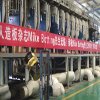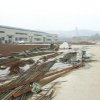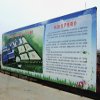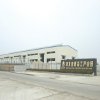Baoyuan to be first in race to make OSB
14 June 2010Hubei Baoyuan Group Co Ltd was established in 1970 as a state-owned coal mining company. Partially privatised in 2000, the company diversified into panel production with its first MDF line in 2002.
That first line, in Jingmen City, Hubei Province, was supplied by Shanghai Wood Based Panel Machinery Co Ltd (SWPM) and had a 12-opening press and a capacity of 50,000m3/year.
At the end of December 2005, Baoyuan started up another line, also in Jingmen City, but this time with a continuous press from Dieffenbacher of Germany and a nominal annual capacity of 150,000m3. Full production commenced in May 2006.
The company also has a laminate flooring line in another part of the same city.
All the employees on the continuous line have come from within the group, including electricians and mechanical engineers, coming from both the coal mining side of the business and the multi- opening MDF line.
The chairman of the board and general manager of Baoyuan, Mr Cai Weijin, said at the time of our meeting in 2006 that he had no plans for further raw board capacity at his 200,000m2 site. But we were only talking about MDF/HDF at that time.
When I met him again at the factory in March this year, Mr Cai said he is very happy with that newest MDF line.
“The line has been running very well since May 2006,he said proudly. “The design is good and the arrangement of the line is also good, with no land wasted. Dieffenbacher, Andritz, Imeas and GTS – all important suppliers on the line – worked together very well.
“Due to this good design and stable equipment, we have made a lot of money and the government has paid more atten- tion to our line; they got a lot of tax! Baoyuan is now an established brand name in the wood based panel industry at a high level of quality.”
Emphasising his point about the government’s gain from his success, Mr Cai gave some figures:
“In 2007, the total MDF capacity of the company, including the 50,000m3 from the SWPM line, was 190,000m3 with a turnover of RMB500m and sales income of RMB380m, with RMB100m going in tax to the government,he said.
“In 2008, that capacity was 230,000m3 and turnover RMB510m. Sales income was RMB400m and tax over RMB135m. In 2009, in spite of the global economic crisis, we still paid out over RMB80m in tax.”
Mr Cai was at first strongly in favour of a Mende-type calender press for his second MDF line, but is glad, particularly in view of the foregoing figures, that he chose a CPS instead.
“If we had gone for the Mende line, capacity would have been lower and we would not have made a lot of money and we would not now be building an OSB line.”
The main production on the MDF line is 2-3mm thickness, mainly 2.4mm. “Thin board is very difficult [to produce] and our quality is good. We keep the line clean and well-maintained and have good staff,said Mr Cai.
I can attest to the cleanliness claim as a walk around the factory revealed it to be one of the cleanest I have seen anywhere in the world. The quality of the MDF I saw in the warehouse was also very good–light in colour and with a very smooth surface.
Baoyuan also has a short-cycle laminating line alongside its MDF lines.
So, I asked Mr Cai, why not build another MDF line as it has been so successful?
“So far, although we have been successful and the line makes a lot of money, capacity is low compared to some of our competitors, therefore we are not in strong competition with them,explained the chairman. “Other companies produce more than one million cubic metres a year and some intend to produce as much as three million or more, so I feel there is no opportunity for me – I would have to build many more lines. Also, I think the MDF market in China already has enough capacity and is becoming saturated.”
Mr Cai also felt that the wood supply available to him was very good and he was getting feedback from his sales agents that there was a demand for OSB in the marketplace.
“In Beijing we have a customer who imports over 100,000m3 a year of OSB from North America and he also advised us to build an OSB plant,said Mr Cai.
There has been talk for years of the possible production of OSB in China and many false hopes raised.
Some years ago, there was reputed to be a small multi-opening line of 10,000m3/year capacity operating in Nanjing, but we dropped this from WBPI’s OSB listings in 2002 as it was said to have ceased operation and was hardly significant anyway.
Mr Cai’s OSB line will certainly be significant when it starts full production towards the end of this year. And it was clearly not a rushed decision on his part to go into this completely different panel product. Careful research was carried out before a final commitment was made.
“I visited Nanjing Forestry University and spoke to a professor who is carrying out research into OSB and he supported the idea. I also went to Europe and North America and visited OSB factories there,said Mr Cai.
“At the WMF exhibition in Beijing in 2008, I invited technologists from Dieffenbacher and Pallmann to come to see our wood raw material and they said that 30 to 50% of the wood that we were then using for MDF production could be used for OSB.”
Since 2005, the local government in Sichuan has encouraged farmers to plant trees and between 2005 and 2009, Baoyuan has itself invested over RMB20m in plantations. The company now owns around 200,000mu (about 13,300ha) of plantations, which form part of a total in the area of more than 1.8 million mu, according to Mr Cai. “But since 2008, a lot of this wood has gone outside Sichuan Province.”
It is never easy to be the first into a new product and Mr Cai is aware of the possible pitfalls.
“Of course going into OSB is a big risk – and a big investment,he admitted. “But I think there is a wide range of potential uses for the product. I think the main market will be in export packaging, which is already accepted in many mar- kets worldwide. I also see it being used in furniture – especially kitchen cabinets – because of its moisture-resistance and strength. So far in China that market has gone mainly to particleboard but OSB will be much better.
“Other uses could be in structural flooring and in decoration in public or private buildings, where it will have the advantage of MDI as a formaldehyde- free binder.”
Mr Cai feels that there is also some potential for the use of OSB in house building but that it will be different to Europe and the US and be a much smaller market.
“I think the housing market for this product will increase because it is the government’s policy to improve the housing of farmers, so maybe there will be a big market for the future. The houses could be built more quickly [with OSB] and they would be safer in earthquake areas.”
What does seem certain is that Mr Cai’s company will not be alone in the OSB market for very long. The major machinery makers all report several active enquiries from other panel producers in China who are considering entering the OSB arena and it seems likely other contracts for machinery will soon be placed.
All eyes will be on Baoyuan when it starts production later this year to see where its panels go and how well they are received.
Given the track record of Mr Cai’s MDF lines in terms of cleanliness and board quality, it seems likely the first significant production of Chinese-made OSB will set a high standard for any future producers to match.



